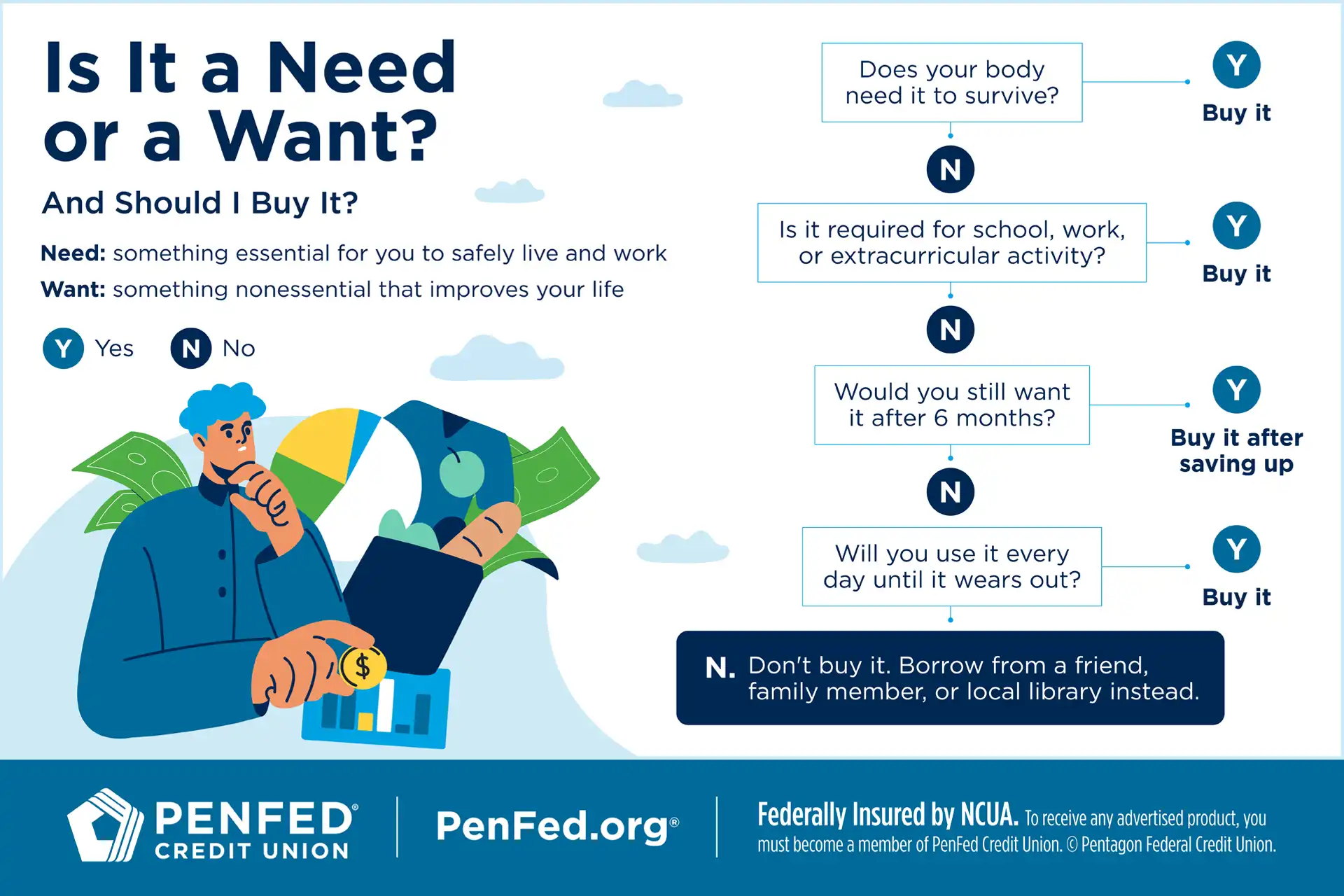YOUTH FINANCE
For Teens: How to Determine Needs vs. Wants
What you'll learn: The most effective way to think about spending money
EXPECTED READ TIME:7 minutes
Age group: 12-18 years old
Imagine sitting down with your laptop one day, opening the lid, and discovering it’s dead. Not “I forgot to plug it in” dead — really finished. You have some money in savings you could use to buy a replacement, but it would cost most of what you’ve been saving for months. Do you need to buy a new one?
The answer might be more complicated than you think, but we’re here to help! First, we’ll explain the difference between needs and wants so you can decide what to spend your money on. Then we’ll talk about how this concept can set you up to manage your money better when you’re on your own one day.
How Are Needs and Wants Different?
Needs are things you have to have to survive. Your most basic needs include food, water, and shelter, but you have other needs, too. Some needs enable you to go to school or work, such as proper clothing and transportation. Others, like electricity and medical care, help keep you safe.
Wants are things you’d like to have. We usually want something because we think it will make our life better. For example, you might want a certain smartphone because it has better features, or a certain brand of clothes because they’re stylish. You can live without wants, but life might be better if you have them.
You can live without wants, but life might be better if you have them. Needs are things you have to have to survive.
Examples of Common Needs and Wants
Below are examples of common needs and wants. Can you think about three things you need for your favorite educational interest (music, robots, writing, coding, sports, etc.)? What about three wants? How would your wants help you achieve your educational goals?
|
Needs |
Wants |
|---|---|
|
Safe home |
House in a fancy part of town |
|
Healthy food |
Dinner at a nice restaurant |
|
Transportation to school or work |
A brand-new sports car |
|
Clothes |
Designer clothes |
|
Hygiene items (toothbrush, soap, etc.) |
A spa day |
Needs, Wants, and Basic Budgeting
A budget is a plan for how you will use your money. Good budgets include:
- Your needs and how much they cost
- Your savings for emergencies*
- Your long-term savings
- Your disposable income (the money left after all your bills are paid and savings goals are met)*
*You probably don’t need to worry about these yet, but once you have your own place and work takes the place of school, they will be very important! While we would never encourage you to grow up too fast, it’s never too soon to be informed about money.
Wanting stuff isn’t bad, but it’s important to be smart about how you spend your money.
You’ll notice a budget isn’t divided between just wants and needs. It also includes savings for emergencies and long-term savings to grow your money. Saving helps you in two ways:
- By preparing you for unexpected expenses like a flat tire or a shattered phone
- By helping you meet long-term financial goals like buying a car or paying for college
Knowing your needs and wants is important for making a budget. You have to prioritize your needs before you can set savings goals, and you should prioritize saving over purchasing wants. This is the best way to avoid debt, gain wealth, and afford some of your wants.
So repeat after us: Needs > Savings > Wants. That’s your money mantra. Practice until it becomes second nature and your adult self will thank you!
You have to prioritize your needs before you can set savings goals, and you should prioritize saving over purchasing wants.
Thinking About Purchases as Needs or Wants
Many people divide their needs from their wants when they create a personal budget. This makes it easier to prioritize needs — like rent, utility bills for power and water, and car payments — over extras such as streaming subscriptions, clothes, or hobbies.
Understanding needs and wants can also help stop impulse buys. Impulse buys happen when you see something, get excited, and buy it without thinking about the opportunity cost. You can think of them as spontaneous wants.
Check Yourself
Lots of impulse buys happen in checkout lines of stores. How often do you pick up a pack of gum, candy, or other small items while waiting to make a purchase?
One impulse buy isn’t a big deal, but habitual impulse buying could keep you from affording the things you really want or need. Thinking about your purchases as either needs or wants can help you resist temptation and stay on track with your budget.
Just because something meets a need doesn’t mean it’s the right financial choice if there are other options that fit your budget better.
Using Needs and Wants to Make Smart Financial Choices
Telling basic needs and wants apart is pretty simple, but it can get tricky when they overlap. Just because something meets a need doesn’t mean it’s the right financial choice, especially if there are other options that fit your budget better.
Consider the example in our introduction where you discover your laptop has stopped working. Is a new laptop a need or want in that situation?
First, think about whether your laptop is essential. If you mostly use it for watching movies or playing games, then it’s a want. But what if you rely on your laptop for school or work? Then it might be a need — but do you have to buy a laptop, or can you borrow one from a friend or family member, or use one at school or the public library? If so, then buying a laptop falls in a gray area between needs and wants.
Say you decide you will buy a new laptop, and you’re excited because you’ve had your eye on one with some awesome features. A budget laptop would meet your needs if you’re just using it for research, essays, and presentations. While a new laptop is a need, the upgraded laptop is a want. However, this too can be a grey area. If you’re taking courses that require intense coding or digital design work, video editing — that sort of thing — the upgraded laptop is a need.
Thinking Critically: Gray Areas
A “gray area” need is something that is kind of a need, but also kind of a want. In the example above, you might need a computer to do your work but you could do that same work on a computer you don’t own. So a computer is a need, but buying a computer is a want. Which of the following are gray area needs and why? Are there alternatives that would work just as well?
(1) A textbook for every student to take home daily
(2) A car to get to school or work
(3) New running shoes

It’s OK to Give In to Wants Sometimes
Wanting stuff isn’t bad, but it’s important to be smart about how you spend your money. Buying too many wants too often won’t leave you money to cover your needs and meet your financial goals. Before buying a want, make sure you:
- Have enough money to cover your basic needs
- Have enough extra money to cover the price of your want without borrowing money
It’s possible to pay for wants using a credit card, but this isn’t a healthy habit to get into when you’re first starting to manage your own money. Credit cards charge fees and interest on your purchases, meaning you’ll pay more than the item is worth. Plus, it’s easy for credit card debt to get out of control.
The best way to buy wants is to set a savings goal and wait until you can make the purchase without going into debt. Not only will you save money, but you’ll have time to reflect on whether you really want to spend your money this way or if you might regret the purchase.
No one is born knowing how to manage money. It takes practice, even for adults!
The Takeaway
No one is born knowing how to manage money. It takes practice, even for adults! Getting a good grasp on the difference between needs and wants creates a solid foundation for other challenges like creating a budget and understanding credit.
Set and Reach Your Savings Goals
Uncover the basics of personal finance with PenFed’s Youth Finance article series.




